
It then spotted us...

...but continued to dine despite our presence.
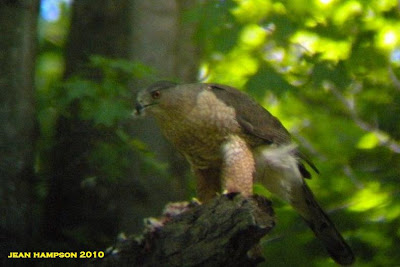
Oops! I dropped my dinner.

The hawk picked up its prey and carried it to another roost to finish off its meal.
Birding, hiking & nature, with a dash of cycling, in southern Ontario.








Strolling around the lagoons in the usual clock-wise direction, we observed our first of the year Green Heron as it flew across the south lagoon.
Leaving the lagoons, we walked on the side trail below the Niagara Escarpment where we encountered a rare flying squirrel in the fall of last year. No squirrels this time, but we found a raptor enjoying a late afternoon snack. Look for a future Niagara Digiscoping post that will reveal the bird we enjoyed viewing on the slopes of the Niagara Escarpment.
Still on the high of ticking 5 lifers in the Carden Alvar, we began our June birding by hiking on the Merritt Trail. Migrating warblers heading north have been and gone so it's back to searching for any bird needed for the year list. 29 avian species observed during the walk, one more would have been nice to make an even 30. Again, no Redhead but we ticked Cedar Waxwing, removing another much needed bird from the year's target list. In addition to the bird observations, we had some great scope views of a family of beaver (3) in the creek below the trail.
The next two ticks were planned. On June 6, we walked the trails of St. Johns Conservation Area to find Scarlet Tanager. Our first tanager observation of the year was a uniformly green female on the wide path as we approached the St. Johns Ridge Trail.


We observed 4 males as we continued our walk in the conservation area.
A week later (June 13), we went to Short Hills Provincial Park to find another reliable tick.


This time the bird was blue. Within 15 minutes of entering the park from the Roland Road entrance, we heard and saw an Indigo Bunting.


Continuing with the blue theme, Jean and I ticked a second species as we walked along the Paleozoic Path. The beee-bzzz of a Blue-winged Warbler was heard. The warbler continued to sing but it would not make an appearance and eventually moved on. I have seen Blue-winged Warbler on previous occasions, including in this provincial park, so I'm counting this tick.

For more information on the Carden Alvar check out Ron Pittaway's excellent birding guide found on the OFO site. Ron also wrote the Hot Spots Near You article for the Carden Alvar in Birder's World Magazine.
Jean and I travelled to Orillia (less than an hour west of Kirkfield) the day before to avoid a 2.5-3 hour early morning drive. Saturday evening we explored the area east of Lake Simcoe and found an Osprey nest atop a utility pole. Little did we know that we would encounter quite a few more the following day.


The group met in Kirkfield for the OFO trip led by Jean Iron. Assisting Jean on the day were Ron Pittaway, Ron Tozer and Eleanor Beagan. Wylie Road was our first stop and Ron Pittaway describes it as "the best early summer birding road in southern Ontario".
While parking the car I immediately noticed the Poison Ivy along the roadside. Where the side of the gravel road ends and the green vegetation starts, the three leaved plant is quite common. When looking at a lifer bird, pay attention to the location of your feet.
The group walked north along Wylie Road and I easily ticked 3 species of blackbird which include our first grassland species of the day, Bobolink.

The purplish hues in the field are that of the wild flower Prairie Smoke. The alvar provides the environment required for the prairie species to grow.

Not too long into the hike Jean and I ticked our first spare (addition to the year list) of the trip. An Upland Sandpiper was spotted on a fence post along the east side of Wylie Road. Soon after, Ron Tozer's discussion of the nesting boxes along the road was interrupted by one of the target birds. Shrike! It was distant but Jean and I had some great views of our first lifer of the day through our scope. The Loggerhead Shrike entertained the group as it disappeared and reappeared moments later atop a new perch. In the same area, we observed our second spare of the day. A Brown Thrasher! This was a very worthy tick. Despite attempts at observing this species last year it was not added to the 2009 list. And then another spare. Grasshopper Sparrows (3) were spotted in a few locations along the road, including during our stop at the Windmill Ranch viewing area.
Further north along Wylie Road the scrub to our left became denser. A song that I never heard before was coming from this area. The trip leaders informed us that the bird singing was a Golden-winged Warbler. If I was able to get on it, I would have another lifer. Another birding couple knew Jean and I needed this species and quickly grabbed us when they had it in their scope. It was a rear view of the bird as it sat near the top of a tree so those of us observing the warbler could only see a yellow crown and what appeared to be a black ear patch. When Ron Tozer got on the bird he quickly informed all that it was a Chestnut-sided Warbler. The streaking on the back indicated that this was not the lifer bird we thought we had. All was not lost though. A Golden-winged Warbler was still singing somewhere in the scrub. This time, we would get on the right bird. A male Golden-winged Warbler in all his glory was on some bare branches and provided a great view for all.

Yes, black throat; black ear patch bordered in white; yellow crown and wing patch. This was definitely a Golden-winged Warbler! Lifer #295.
You can see that I could not contain my excitement after viewing the lifer warbler.

After walking 2.5 kilometres the group reached the Sedge Marsh. Wylie Road cuts through the marsh and continues north until it reaches Alvar Road. The marsh is a reliable spot for finding Sedge Wren. The first wren observed though was a Marsh Wren, another spare for the day. Another spare was ticked as 2 American Bitterns were observed flying low through the reeds west of Wylie Road. We soon had our third lifer of the day. A Sedge Wren was singing from the top of a bullrush. It would move to a bush but we still had great views of lifer #296.
Further up the road, Jean Iron picked out the call of an Alder Flycatcher. This would be another lifer if we found it. Not only did we find it (lifer #297) but Jean, "My Jean" (I call her when on trips lead by Jean Iron), was first to see it through her bins and describe its location to the trip leader. This was turning out to be a great day! Four lifers along one stretch of road. Ron Pittaway is right. This is a great rural road for birding! It was time to head back to the cars and stop for lunch at the Kirkfield Lift Lock.


After lunch we drove the cars to Shrike Road to observe a Great Blue Heron rookery. In the pond we found a rare Ontario species. It was not avian though. It was a Blanding's Turtle. A lifer reptile!

We turned around on Shrike road and headed east along McNamme Road. As the line of cars was coming to a stop, Jean Iron flushed a Ruffed Grouse, almost hitting it. Most of the group would not observe the spooked bird. A miss for Jean and I. The group scanned the fields south of the road for more target birds. Upland Sandpiper (2) were seen and another distant Loggerhead Shrike. Great to see that there may be 2 nesting pairs in the area.
Our next stop was at the causeway on Canal Lake. Here we found 2 pairs of nesting Osprey at both ends of the causeway. While stopped at the north side of Canal Lake we observed a few gulls (Herring and Ring-billed) and a Common Loon. Two more loons (a pair) were observed on the south side of Canal Lake.
From Canal Lake the group headed south to Prospect Road. The road runs south from Kawartha Road 48 and takes you through Prospect Marsh. We stopped at the marsh to search for bitterns, rails and wrens. Marsh Wrens were popping up out of the reeds and singing from the top of bullrushes. A favourite perch I assume.

Both Virginia Rail and Sora were calling but were well hidden from the group's view. OK. This is where counting a bird gets tricky. At least for me. A Virginia Rail is a lifer so it also needs to be seen by both Jean and I to be added to our lists. We had only observed Sora twice before this trip. As you can see, we have not seen many Sora at all. Should I count the Sora calling in Prospect Marsh? Ron Tozer brought his "old school" tape player and played recordings of both the Virginia Rail and Sora calls. This caused some movement in the reeds behind the group (west side of the road). A member of the group finally observed the bird as it quickly moved through the reeds. Patience paid off and both Jean and I were able to observe our 5th lifer of the day as it ran between clumps of reeds. Virginia Rail! Lifer #298. The Sora continued to call from the marsh on the east side of the narrow road. At times it was right in front of me but not one of us could get on it. Jean decided we should count the Sora and I totally agreed. It was less than 2 metres from us while calling. Another spare in the Carden Alvar.
Our last stop was further south on Prospect Road. Stopping in an area filled with scrub we searched the field, listening to a song Jean and I heard for the first time two weeks ago. Our last observation of the day was a Clay-colored Sparrow.
A great day was had by all. Jean and I observed a total of 48 species in the Carden Alvar. Considerably less than the number (75 species) tallied by Ron. If only one member of the group sees a bird it is still added to the trip list. As you can see there were some misses.
A Black-billed Cuckoo was only seen by Ron and one other OFO member while we were at the causeway. It flew away before Ron could attract the attention of the rest of the group. Another bird missed by Jean and I was an Eastern Towhee on Wylie Road. Hopefully we can tick one while birding in the Niagara Region.
In total, 12 species were added to our year list. 3 misses, 12 spares and 5 lifers. A great day of birding which might not be matched for quite some time. This trip may become an annual one. It should if I want to continue a 200+ species list every year. Of course I still have to accomplish that for the first time this year. There are a number of shorebirds that still need to be ticked. Looks like the next OFO trip we will attend will be at Rock Point in August. Perhaps a Baird's or Buff-breasted Sandpiper will be our 300th lifer. I think I can wait though. I really don't want June and July to go by that fast.
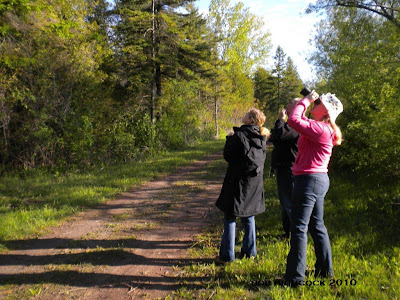

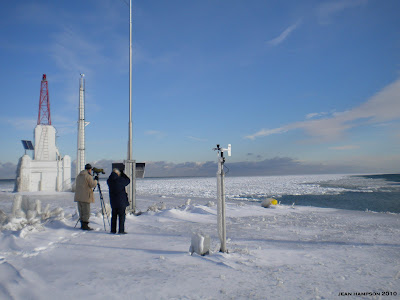


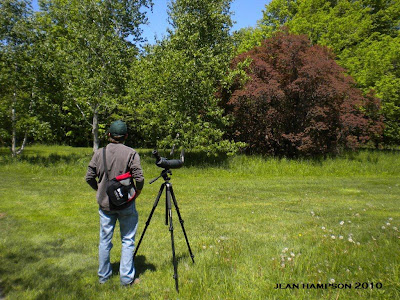
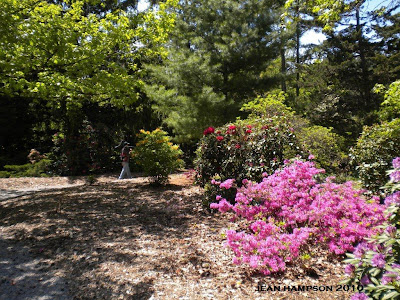



No Bobolink yet and unfortunately no Upland Sandpiper either. The Bobolink should return to the area in another couple of weeks.
We then went to the Merritt Trail to look for the Red-headed Woodpecker. The bird remained out of our sight but we added Wood Duck and Yellow-rumped Warbler to the year list. Yes, warbler migration has started.
April 22
What better way to celebrate Earth Day than with a morning of birding. At the eco park near Lake Ontario we searched for early migrants. Yellow-rumped Warblers (they usually are the first observed) were flitting in the trees. A Caspian Tern flying above the Welland Canal was the only first of the year this fine morning.
In the evening we visited the Green Ribbon Trail with hopes of ticking Fox Sparrow. Earlier attempts in the month of April came up empty. For the last three years we have found this spring migrant on the paved trail that crosses Martindale Pond. No spring sightings of the "Red" Fox Sparrow this year. We'll have to wait for the sparrow's return in the fall.
April 23
We returned to 5th Avenue with Jean's dad and his partner Ruth. They were eager to view the meadowlarks. Horned Lark and Savannah Sparrow were observed but the meadowlarks could not be found. On to Mud Bridge for a possible early, first of the year Cliff Swallow. Jean and I observed our lifer Cliff Swallow at this location in early June last year. Though none were seen this day we will return at a later date for a first of the year tick.
May 1
Chimney Swifts have returned to our neighbourhood. I observed one lone swift as it chattered and flew above our yard. Last year Jean and I counted the swifts for the Bird Studies Canada Chimney Swift monitoring program as they entered the chimneys of the Lake Street Armoury. As of June 2 the numbers of swifts sighted from the yard has increased to six. If there is another watch this year, count us in.
May 2
Jean and I travelled south to the Port Colborne area to add Woodcock to the year list. In April of 2009 we observed 1 Woodcock while exploring property owned by a friend.
We visited Mud Lake Conservation Area first and added Blue-winged and Green-winged Teal to the year list.

While walking along the trail above the man-made lake we observed a Yellow Warbler.
No Woodcock this year while visiting our friend's property but we added Spotted Sandpiper and Common Yellowthroat to the 2010 list.
May 6
A casual observation on the way to work added Baltimore Oriole to the list.
May 8
While birding in the eco park during spring migration you are guaranteed to run into fellow birders. This was our first visit during the month of May and our birding friend Katherine arrived as we were scanning the trees for warblers. Katherine has a great ear for birds and with the three of us working together we were able to get on some good birds. Warblers spotted included, Black and White, Black-throated Green, Blackburnian and Cape May. This was the first time Jean and I observed a Cape May Warbler in the spring. It is a beautiful bird! There are several trails in the park and Katherine went one way while Jean and I headed over to the west side of the park where we found 5 Rose-breasted Grosbeak (3 males and 2 females) feeding on the blossoms of an apple tree. Running into Katherine again I returned the favour and told her where she could observe the flock of grosbeaks.
May 9

After visiting the lilac gardens on the Niagara Parkway we had great views of an American Redstart during a Mother's Day walk with my parents at Dufferin Islands.

Over the 2.5 week period Jean and I observed 18 first of the years but we are behind last year's pace by 11 species. We have some birding to do. Our next big day of birding was a great asset in adding birds to the year list. On May 16 we assisted with the Buffalo Ornithological Society May count and before Jean and I started counting in our assigned area, we had great views of LIFER #292. You'll have to wait for the next post for that one. It's an epic one!